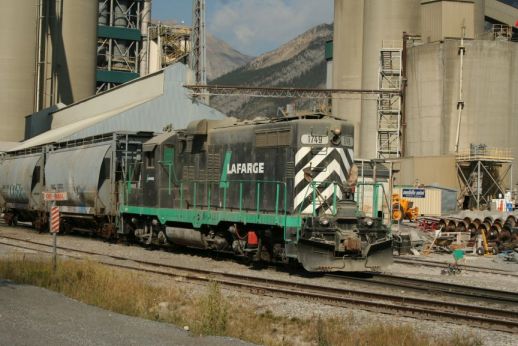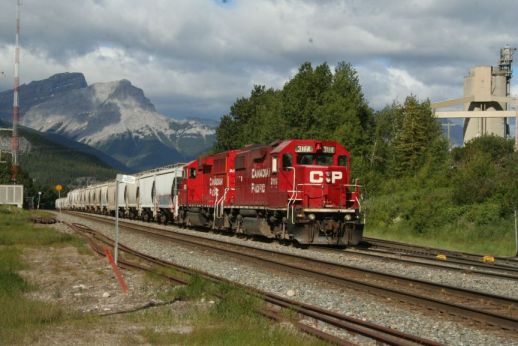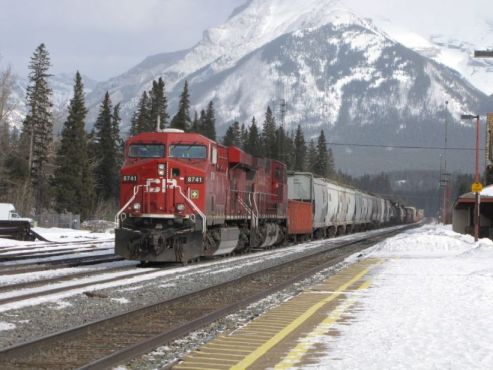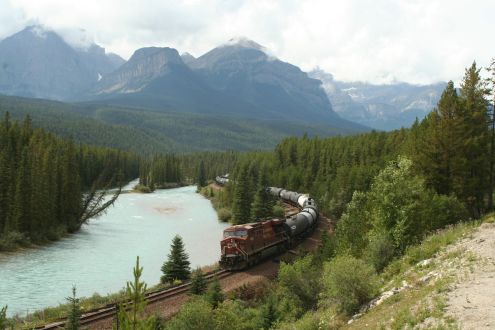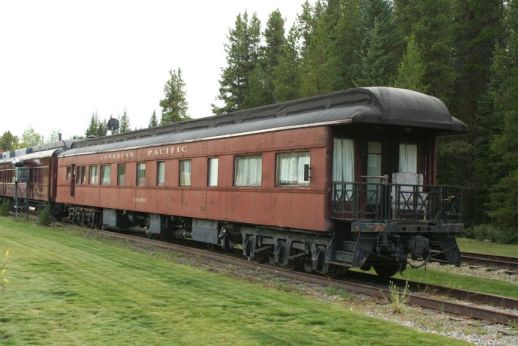
Canadian Pacific’s Laggan Subdivision, which is 136.6 miles long, runs from Calgary, Alberta to Field, British Columbia. The line parallels the Trans-Canada Highway and Bow River, passing through the towns of Cochrane and Canmore before entering the beautiful Banff National Park. It passes through the park’s namesake town before heading to Lake Louise where it leaves the Bow River Valley to ascend the Kicking Horse Pass and enter British Columbia.
The Laggan Subdivision starts in downtown Calgary and heads west through both the southwest and northwest quadrants of the city. From Sunalta the line is mostly single track with several passing loops, the first was at Brickburn in the community of Bowness but this was removed in 2013. To the west of Brickburn is Keith Yard which, until the mid 2010’s, had been a large yard but the majority of the sidings were then lifted. At the west end of Keith Yard are the city limits and the railway enters Rockyview County, heading towards the town of Cochrane.
From Cochrane to Seebe, the railway passes through the Stoney Nakoda Reserve and, while there are many great views, getting trackside is not easy. Just west of Cochrane is the Copithorne Spur heading south to Shell’s Jumping Pound gas plant.
At Seebe, the railway enters the Municipal District of Bighorn #8 and passes through the village of Exshaw, site of a Lafarge cement plant that has its own industrial locomotive. Immediately to the west of Exshaw is the Greymont Spur which leads to the Baymag magnesite plant.
At the eastern edge of Banff National Park is the town of Canmore which, until 1930, had been part of the park but was removed due to mining activity in the area. To serve these mines, there had been several spurs built, including a 29-inch narrow gauge electric railway. Visitors driving through the town can still see some of the former narrow gauge cars on display at various locations.
Approaching the town of Banff the railway passes through the ghost town of Anthracite, a coal mining community that had been founded in 1886 and abandoned in 1904. Just to the west of Anthracite is the now abandoned spur that ran to the village of Bankhead, another coal mining town founded 1903 and abandoned in 1922.
The town of Banff was founded in 1883, originally called Siding 29 before being renamed later that year. The first station was built to the east of the current station, and replaced in 1888 by a log station on the current location. This station was rebuilt in 1910 and is still used by the Rocky Mountaineer.
Banff is home to the former Canadian Pacific’s Banff Springs hotel, one of two hotels in the park built by CP, and is located just over two kilometres south of the station. The current hotel dates back to 1928, built after a fire destroyed the previous building.
The original plan had been to build a tunnel under the small mountain immediately to the southwest of Banff. This plan was ultimately rejected and the current route was instead selected. However to this day, the mountain is known as Tunnel Mountain.
There are only two wyes on the Laggan Sub and one of these is on the north side of Banff yard while the second is located at Eldon to the west. Between Eldon and Lake Louise is the famous Morant’s Curve which offers stunning views of both the Bow River and surrounding mountains behind the railway.
From Lake Louise, which had previously been called Laggan until 1916, the line is double tracked on separate grades as far as Stephen with the north line having a gentler grade. Only the southern track serves Lake Louise station, where three former CP passenger cars are located.
High above Lake Louise station is Chateau Lake Louise, the other former CP hotel. From 1912 to 1930, visitors could travel to the hotel by the Lake Louise Tramway which was a 42-inch gauge railway built by CP. Although the rails were lifted in 1931, the old track bed is still visible from the road and is now used as a trail.
After climbing up the Kicking Horse pass the line crosses the Continental Divide and passes Stephen before descending to Field, British Columbia. As originally built, this section of the main line was known as the Big Hill with a ruling grade of 4.5% and, to prevent runaways, there were three safety switches installed. With the opening of the spiral tunnels in 1909, the Big Hill was closed and today the route is used by the Trans-Canada Highway. Just to the south of the former line are the remains of a 36-inch narrow gauge Baldwin 2-6-0 steam locomotive that had been used in the construction of the spiral tunnels.
There are two spiral tunnels, the upper tunnel is under Cathedral Mountain, high above the Trans-Canada, while the lower is below the Trans-Canada and is the one that most people are familiar with. From the lower spiral tunnel, the train descends the remaining distance into Field. Heading west from Field is the Mountain Subdivision which runs to Revelstoke, BC.

